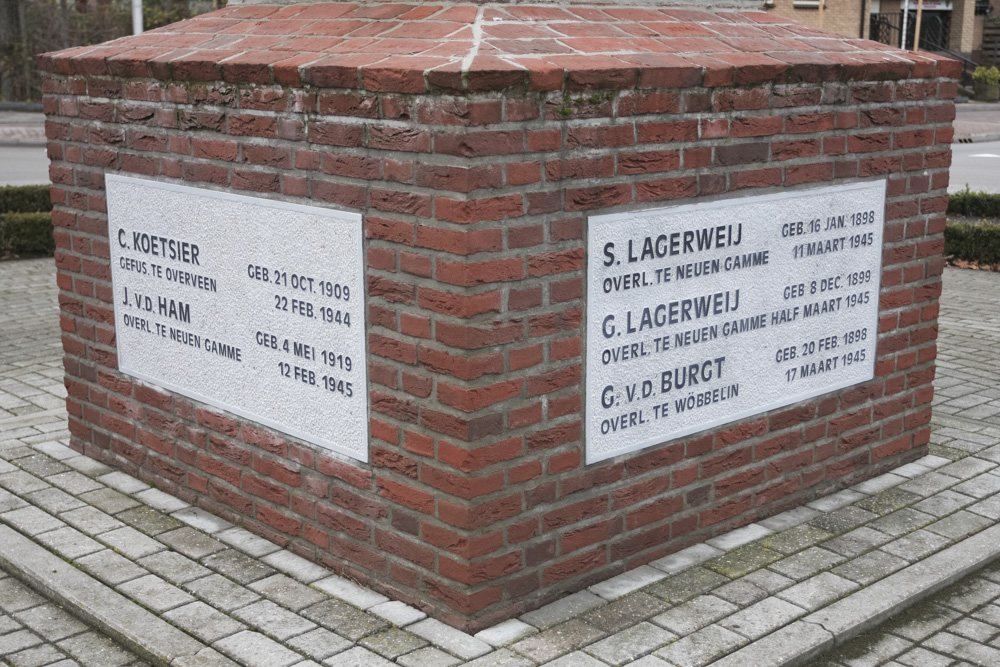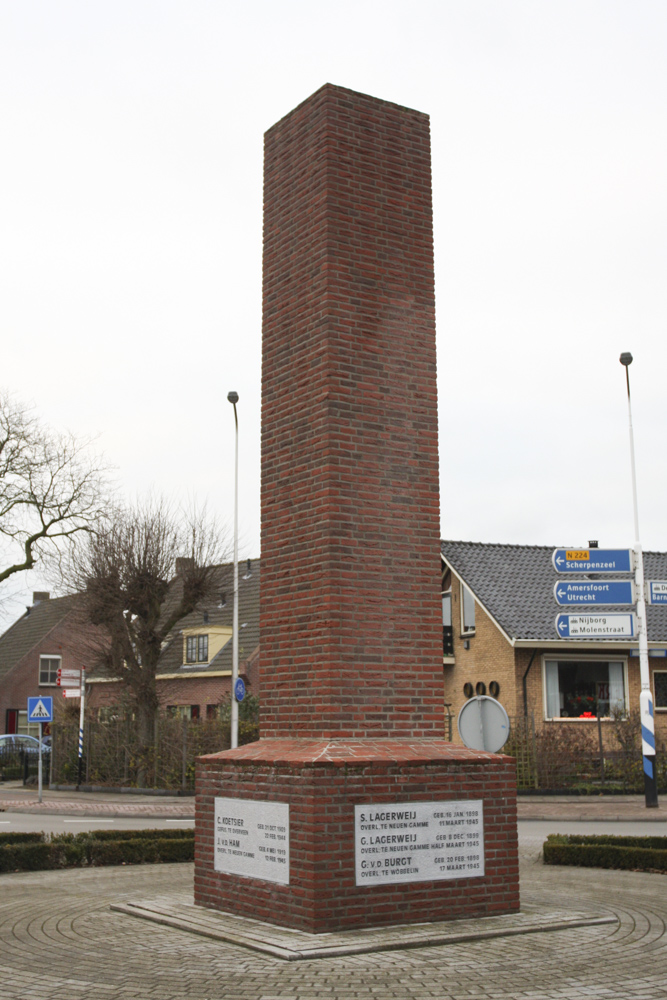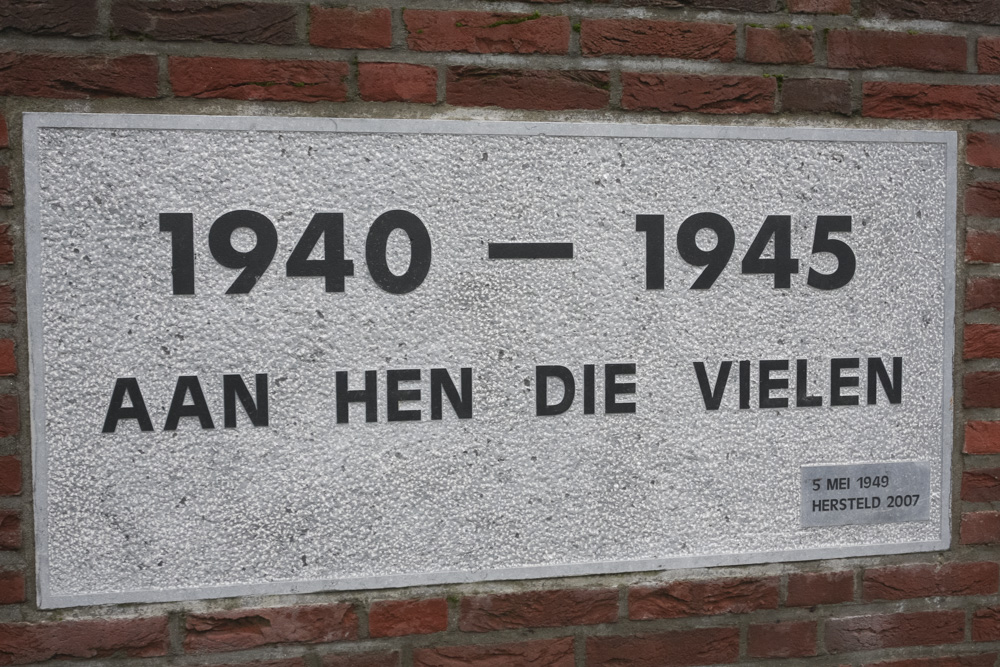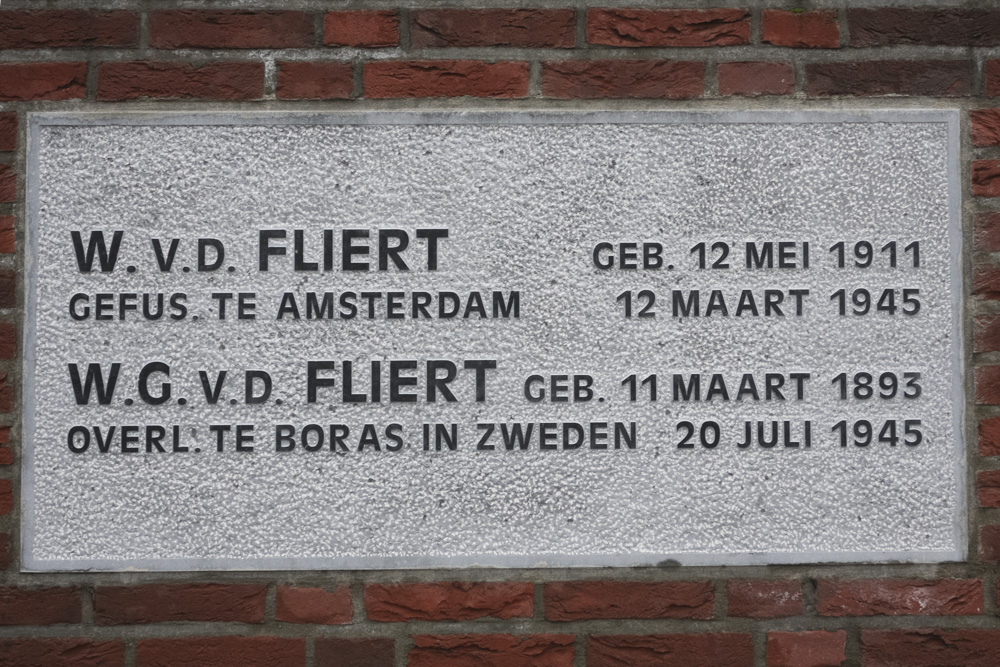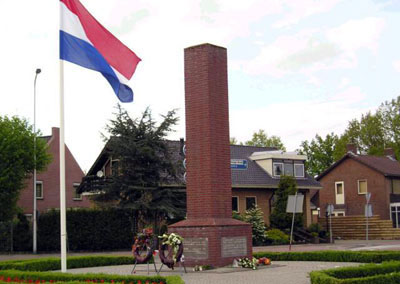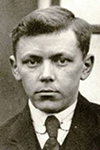Resistance Memorial Renswoude
The resistance monument in Renswoude is a brick column, placed on a square base. Four freestone memorial plaques are laid in the base. The whole is 5 meters high, 1 meter 50 wide and 1 meter 50 deep. The memorial plaques bear the names of seven killed resistance fighters from Renswoude.
In 1942 the resistance to the occupier started to grow in Renswoude. The resistance in Renswoude worked together with Veenendaal. Many distribution offices were raided and sabotaged. Sander Lagerweij's farm 'Groot Overeem' (born 16 January 1898) on Molenstraat was a shelter for people in hiding and resistance fighters. Furthermore, weapons and ammunition were also hidden here, which were dropped at 'De Dennen' in early December 1944. Sander's brother, Gerard Lagerweij (born December 8, 1899) was also active in the resistance. His resistance work started on a small scale with some food and a few days shelter for Jews. Later, his farm 'De Beek' was also a shelter and weapons and other material were stored in the yard. At the end of 1944, due to an unfortunate combination of circumstances, the Feldgendarmerie raided the old homestead at the Lunterse brook in Renswoude. Sander Lagerweij was just on his brother's farm when about thirty people surrounded the yard. A lot of incriminating material was found and by the evening seven people were taken to 'Huize Scherpenzeel' for questioning. The next day, fourteen people were arrested on or near the farm and taken together to the Willem III barracks in Apeldoorn. Seven people were subsequently deported to Neuengamme or the surrounding area and never returned. Sander Lagerweij died in Neuengamme on March 11, 1945. Gerard Lagerweij has no known date or place of death.
Willem van de Fliert was born on May 12, 1911. After Gerard De Lagerweij's 'De Beek' farm was attacked by the occupying forces, Van de Fliert made his 'Groot Wagensveld' farm available for the resistance. On March 7, 1945, the Feldgendarmerie also raided here. A traitor had reported him. Willem van de Fliert, Sander de Kleuver and Henk Hekking were taken behind the farm wagon to Doorn. Then they were transferred to the prison at the Weteringschans in Amsterdam. Sander and Henk belonged to the resistance group Renswoude and their conviction was not long in coming. Five days after the arrest, on March 12, 1945, Willem van de Fliert was led in front of the firing squad in the Weteringplantsoen in Amsterdam and shot.
Willem Gijsbert van de Fliert was born on March 11, 1893. He lived on the Barneveldsestraat in Renswoude. He had served on the city council, but also on the school board of the Christian school. In addition to his farm, he had a hatchery. In the fall of 1944 he was betrayed because he had a radio in the house and because people were hiding in one of his chicken coops. Van de Fliert was deported to an internment camp in Germany. After the Americans liberated this camp, Van de Fliert arrived sick and exhausted in Boras (Sweden), where he lived until July 20, 1945.
Jan van den Ham was born on May 4, 1919 on the Biesbosserweg in Renswoude. He lived and worked in Jutphaas. He was a controller of the Central Crisis Control Service (C.C.C.D.). During the war, he joined the resistance. In September 1944 the occupier awaited him when he got home. Van den Ham was arrested and ended up in Neuengamme after a long journey. Here he died on February 10, 1945.
Cornelis Koetsier was born on October 21, 1909. He was a baker in Renswoude. He also ended up in the resistance. On January 23, he was arrested and locked up in the House of Detention in Amsterdam. In the news of the day of Thursday, February 24, 1944, the following was reported: 'The convicted Coachman admitted that weapons were brought into his house to be handed out to members of the gang, who also received them. Here, only the death penalty was eligible for conviction. The sentence was executed on February 22, 1944. " Kees wrote a few letters from his prison in Amsterdam to his wife and children, his mother, brothers and sisters. He was executed on February 22, 1944 in Overveen.
In 1946 the committee 'Establishment of Memorials' was formed. Initiators were Messrs. H. Vermeulen (chairman), J. Van 't Riet (secretary) and W. van Buren (treasurer). The monument was unveiled in 1946.
Do you have more information about this location? Inform us!
Source
- Text: Gemeente Renswoude
- Photos: Arjan Vrieze (1,2,3,4) & Barry van Veen (5)
Nearby
Museum
- Museum Grebbelinie in het Vizier - Woudenberg
- Pantherstellung - Bunker R010-P "Museum Bunker Grebbelinie" - Leusden
Point of interest
- Lieutenant Rowe bridge - Renswoude
- Grebbe Line Visitor Centre - Renswoude
- Information Sign Hoofdstraat 106 Veenendaal - Veenendaal
Monument
- Memorial Renswoude Cemetery - Renswoude
- Monument Halifax W7930 - Renswoude
- Resistance Cross Memorial - Renswoude
Cemetery
- Dutch War Graves Renswoude - Renswoude
- Graves Belgian Refugees Veenendaal - Veenendaal
- Dutch War Graves Veenendaal - Veenendaal
Remembrance Stone
- Stumbling Stones Prins Bernhardlaan 178 - Veenendaal
- Stumbling Stone Julianastraat 11 - Veenendaal
- Stumbling Stone Hoofdstraat 100 - Veenendaal
Fortification
- Anti-tank Barrier Renswoude - Renswoude
- Grebbe Line - S3 Casemate GL135 - Renswoude
- Prolapsed Bunker Renswoude - Renswoude
